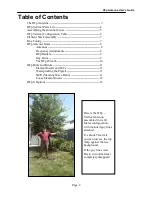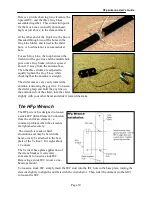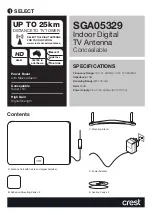
HFp Antenna User’s Guide
Page 9
2.
Lowering the resonant frequency
– Moving an inductive load position lower in the
antenna will lower the frequency. This can be accomplished by turning over one of the
loaded elements (putting the stripes “down”), or moving it down in the assembly of
elements.
Adding a zero- or a 1-stripe element (making the antenna longer) will also lower the
resonant frequency. And extending the whip will lower the resonant frequency.
The HFp Radials
The HFp configuration charts define the tuned length radials for each Ham band, over
moderately damp, conductive ground. These tuned lengths are an important concept in the
proper operation of a ground-mounted vertical antenna. A write-up available on the Ventenna
web site explains the effect of different radial lengths and especially the problems which can be
generated by radials that are too long. Go to "http://www.ventenna.com/Manuals.html", and
download “Radials for ground-mounted Verticals”.
Although we have determined that the HFp will usually operate properly with the three radials
provided, adding radials may help lower the SWR in some situations, particularly in elevated
mount installations or over very dry or stony ground. It is easy to add extra wire to the radial
system to see what effect more radials might have.
You can also affect the performance of your antenna by lengthening or shortening the tuned
radials. Change all the radials the same amount, a little at a time, and follow the “Fine Tuning”
procedure to check SWR. Also, see the "SWR" discussion at the end of this manual.
In the “Radials for ground-mounted Verticals” write-up, you will notice that there is a broad
range of length for the radials which will provide good SWR. Because of this, it is possible to
use one length setting for multiple bands.
Guy Lines for the HFp Antenna
Use of the included Guy Lines is recommended if
you intend to leave the antenna up for any length of
time, or if it is windy. Although the antenna is
quite robust, and can withstand strong winds, it
will tip over (and probably damage the whip) under
windy conditions if it is not guyed.
A Special IEC (Inter-Element-Connector), which
has a short sleeve on it, is used to allow the
element stack to rotate with the Guy Lines
attached. The short sleeve provides a small space
between the element and the nut in the center of the
IEC. The sleeve is crimped in place on the
threaded portion of the IEC.
The ring crimped to one end of each Guy Line has
an opening large enough to allow it to fit loosely over the Special IEC sleeve. Because of the
loose fit, the three rings can rotate freely when the element stack is turned, preventing the guy
lines from wrapping around the element stack.






























